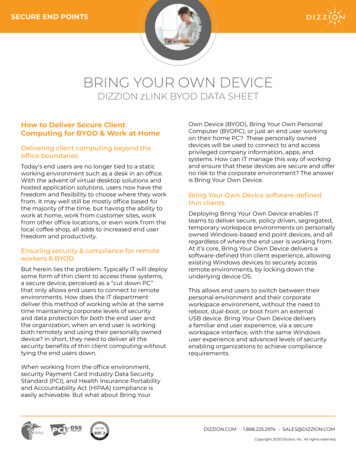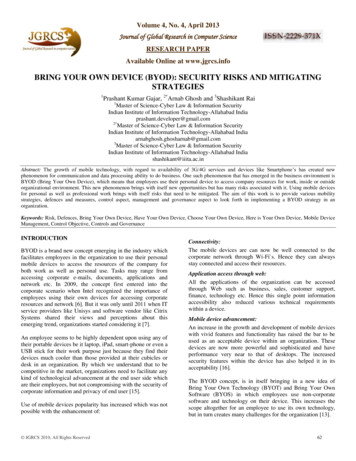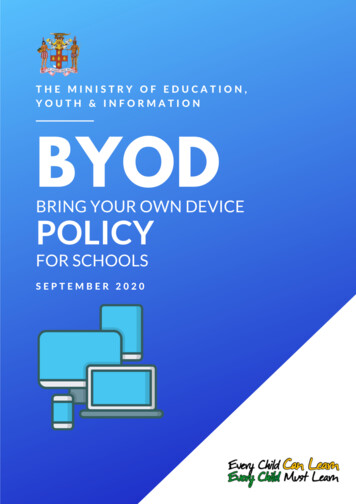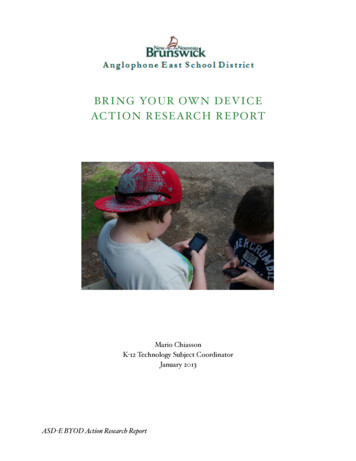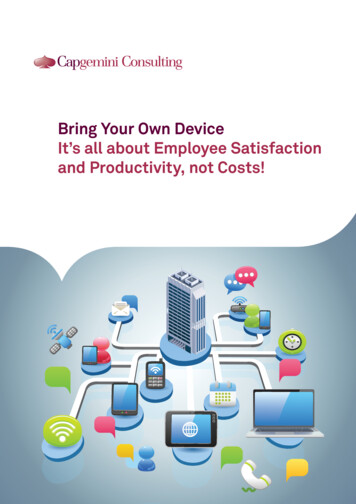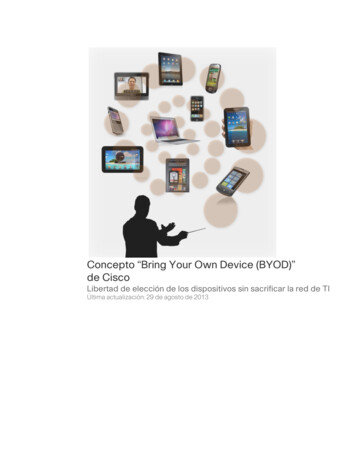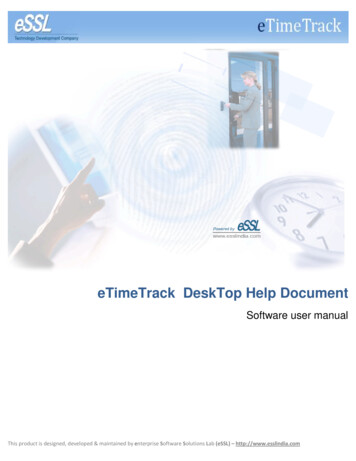
Transcription
Knowledge Management & E-Learning, Vol.11, No.2. Jun 2019“Bring your own device” policies: Perspectives of bothemployees and organizationsKevser Gülnur GökçeOzgur DogerliogluBogazici University, TurkeyKnowledge Management & E-Learning: An International Journal (KM&EL)ISSN 2073-7904Recommended citation:Gökçe, K. G., & Dogerlioglu, O. (2019). “Bring your own device” policies:Perspectives of both employees and organizations. ps://doi.org/10.34105/j.kmel.2019.11.012
Knowledge Management & E-Learning, 11(2), 233–246“Bring your own device” policies: Perspectives of bothemployees and organizationsKevser Gülnur GökçeDepartment of Management Information SystemsBogazici University, TurkeyE-mail: kevsergulnurar@gmail.comOzgur Dogerlioglu*Department of Management Information SystemsBogazici University, TurkeyE-mail: dogerlio@boun.edu.tr*Corresponding authorAbstract: Bring Your Own Device (BYOD) policy, which allows employeesto use their own mobile devices for work and connection to their corporatenetwork, is getting popular in enterprises. While companies want to improvethe efficiency and productivity of employees, employees prefer to use their owndevices at work, which make them feel more comfortable and free. AlthoughBYOD seems attractive, companies and employees have some securityconcerns in different and various ways. The aim of this study is to exploreemployee and organization perspectives about BYOD. Empirical part of theresearch has two parts: Qualitative and quantitative. Manager’s opinions weredetermined through a series of interviews and then the findings were analyzed.In quantitative part, a questionnaire has been developed based on the literaturereview and qualitative findings. 12 interviews and 93 surveys were used in theanalysis. It has been found that while organizations and employees perceptBYOD as having benefits in many ways, their security and privacy concern is astrong barrier on the implementation of BYOD policy.Keywords: Bring your own device; BYOD; Security; Privacy; IT policyBiographical notes: Kevser Gülnur Gökçe has completed her MA degree inManagement Information Systems program of Bogazici University. Herresearch interest is in knowledge management policies of organizations. Shealso works in finance industry as an information security analyst.Dr. Ozgur Dogerlioglu is an Assistant Professor in Management InformationSystems department of Bogazici University. Her research studies and publishedarticles focus on the managerial and organizational impacts of InformationTechnology, learning organization, knowledge management, social networksand embeddedness, quality management and corporate culture. Strategicmanagement, managerial communication and organizational impacts ofInformation Technology are the main subjects of the courses given by her.More details are available at u-2
234K. G. Gökçe & O. Dogerlioglu (2019)1. IntroductionMobile devices play an essential role in people’s lives for the need of easy and fast accessto information (Botha, Furnell, & Clarke, 2009; Markelj & Bernik, 2015). As the lifecannot be thought without them, the use of mobile devices for work is becoming verypopular (Khan, Abbas, & Al-Muhtadi, 2015). Mobile devices offer a wide variety offunctionalities including wireless technology, different types of applications, easy accessand connection and therefore companies have started to give employees mobile devicesin order to keep in contact with them after work hours (Shumate & Ketel, 2014).Nowadays employees want to use their own device for work and deciding whether or notpermitting this request is a new problem for companies (Jaramillo et al., 2013).Instead of using two devices for private and business applications, employeesgenerally prefer using one device that may represent a proper solution. The result is"Bring Your Own Device" or BYOD, which means that employees make their ownpersonal devices available for business purposes (Disterer & Kleiner, 2013). Employeescan use their personally owned devices to access company resources such as email, fileservers, and databases (Hayes & Kotwica, 2013). It is a very controversial subject interms of managerial, technical and security concerns (Disterer & Kleiner, 2013;Tokuyoshi, 2013).1.1. Advantages of BYOD for employeesAlthough allowing employees to bring and use their personal devices for work has somethreats, it also brings some opportunities. The device used by employees for work shouldhave ease of use not to lose motivation. People in the work place become much happierwhen they use their own phone which they like and know. Efficiency and production inthe work environment rise with increased happiness (Cognini, Gagliardi, & Polzonetti,2013). It also results in increased profits. Furthermore, employees can become moreinnovative because they can easily work together and share ideas any time and at anyplace (Waterfill & Dilworth, 2014).Effectiveness and comfort: Employees can feel more comfortable when theyaccess to enterprise network from anywhere, any time without any extra device orconnection (Morrow, 2012; Thomson, 2012). They do not see it as extra workload whenthey work with their own device after work hours. Employees may not stay all day in theoffice and if they leave the office early, they may continue to work at any place whichthey feel themselves comfortable. This is also appreciated by managers for being able tokeep employees performing for longer hours (Madzima, Moyo, & Abdullah, 2014).Employees generally have complaints about company owned mobile devicessince companies give them old technological devices because of budget constraints. Ittakes long time for companies to replace old fashion devices with new and highertechnology ones. It is one of the reasons for employees to prefer BYOD as they do notwant to have trouble with old corporate computing devices (Madzima et al., 2014). Asemployees can use their own devices more comfortably and connect the workenvironment whenever they want, they work more effectively (Zahadat et al., 2015).1.2. Disadvantages of BYOD for employeesAlthough using their own devices leads perceptions of freedom and flexibility in terms ofhow, when, and where they can accomplish the work, it also leads to pressure on the
Knowledge Management & E-Learning, 11(2), 233–246235employees because of being always accessible and responsive to labor demands. BYODcreates stress and tension on users (Fujimoto et al., 2016).Privacy concerns: BYOD can limit employees’ activities on their own devicewith restrictive rules of the organization since BYOD device is used for both personaland business purpose. Users do not have right to choose which application can bedownloaded and installed (Jaramillo, Ackerbauer, & Woodburn, 2014). They are alsoworried about their data privacy because company can access all the personal data forcontrolling the device remotely. Possibility of company access to their personal spacemake users feel irritated (Wang, Wei, & Vangury, 2014).Information Technology (IT) department should cope with security and relatedmanagerial issues. Security solutions are especially important for protecting corporatedata (Rhee et al., 2013; Porter, 2011). However, security solutions for organizationalrisks may create security risks for users.Mobile Device Management (MDM) system is one of the options and it is a typeof security software. MDM software permits administrators to control mobile devices aseasily as desktop computers. It is preferred by organizations for monitoring smartdevices’ status and controlling them remotely in order to prevent any data leakage(Pogarcic, Gligora Markovic, & Davidovic, 2013). Enterprises are developing andadopting mobile device management systems in order to enhance the security of mobiledevices. This type of software also handles the situation when the phone is lost ormisused (Rhee, Jeon, & Won, 2012). Authentication rules, device settings are specified tolimit the access to the corporate data. It also serves wiping feature if it is necessary(Chang, Ho, & Chang, 2014). MDM does not differentiate personal device and corporatearea and it serves a common space for BYOD, it limits the user’s freedom. As userscannot act as free as they want, it can be seen as a negative attribute by users (Wang etal., 2014). Application and desktop virtualization solutions are also used for helping toseparate corporate network from unauthorized employee access (Dong et al., 2015). Inthis solution, users can access corporate network and data with remote access. Althoughuser’s area and corporate systems are separated from each other, some security policiesshould also be implemented to prevent any unauthorized data transfer (Ogie, 2016).1.3. Advantages of BYOD for organizationsOrganizations encourage BYOD because it has many advantages, such as reducingcompanies' cost and increasing users' productivity (Zahadat et al., 2015). Traditionallycompanies provide and manage devices for their employees while BYOD is less costlywhen compared to this traditional option. (Morrow, 2012; Scardilli, 2014). Organizationsget rid of purchasing, maintenance and operational costs of company owned mobiledevices. They become responsible for only configuring the connection between personaldevices and company network (Shumate & Ketel, 2014; Ocano, Ramamurthy, & Wang,2015). Increased flexibility, productivity, mobility and employee satisfaction are the maincontributions of BYOD to organizations (Rivera et al., 2013).1.4. Disadvantages of BYOD for organizationsOrganizations may find the idea of allowing employees to use mobile devices attractiveto keep employees satisfied in today’s life conditions, but also, they face the risk ofhaving corporate data unsecure (Morrow, 2012; Tokuyoshi, 2013). Another problemabout BYOD is managing different types of devices. As the complaints differ for each
236K. G. Gökçe & O. Dogerlioglu (2019)type of device, internal help desk or other departments can have troubles in solvingspecific problems (Cognini et al., 2013; Scardilli, 2014).Security: Mobile devices that connect to enterprise networks significantlyincrease threats to sensitive data if the data is unencrypted (Morrow, 2012; Thomson,2012). Especially mobile hot spots can be dangerous as data is sent via unsecurednetwork (Shumate & Ketel, 2014). Nowadays, mobile devices become very attractive forhackers because it is not as safe as PCs because of unsecured Wi-Fi connection, lessprotective anti-virus system, jailbreak property and user ignorance. The operating systemand application of devices may be affected by mobile threats involving exploits to takecontrol of the whole system, or harmed part of the device (Madzima et al., 2014).Malware, viruses and malicious codes that open backdoor for attacks are also concernsfor data leakage (Chang et al., 2014; Kim & Lee, 2014).Due to the possibility of data loss caused by careless personnel, employees needto feel the responsibility of having corporate data in their mobile (Morrow, 2012;Lennon, 2012). They should know safe usage rules of mobile devices to avoid causingany security breach (Markelj & Bernik, 2015). They should also be aware of threat ofphishing attacks that steal sensitive information from users with deceiving them(Arachchilage, Love, & Beznosov, 2016). Another subject taken into consideration isabout employees who access confidential corporate data by their own device without anysecurity precautions. It is challenging to prevent system and sensitive data fromintentional damage of users. Security agreements including strict rules may be a solutionto deter personnel from malicious act (Madzima et al., 2014).Applications and information placed in mobile platforms must be protected fromany threat that affects the integrity, availability and confidentiality of corporate data. Inorder to keep them safe, the policies about who may access and from where should bespecified (Thomson, 2012). As organizations handle the drawbacks of BYOD, they needto take into consideration the security precautions to safeguard corporate data from bothexternal and internal threats (Miller, Voas, & Hurlburt, 2012).2. Research objectivesThe purpose of this research is to study different perspectives of managers and employeeson BYOD policy. Employee opinions affect company decisions because attitudes andthoughts of personnel are part of any implementation process in organizations. Theresearch model shown in Fig. 1 assumes organizational perspective about BYOD policyto be a combination of managers’ and employees’ perspectives. Manager’s perspective isclarified using qualitative method and quantitative approach is preferred forunderstanding employee perspective. Mobile devices have wide variety of functionalities for achieving work and nonwork activities and let employees to continuously keep in touch with colleagues,families, and friends (Fujimoto et al., 2016). Using their own devices for workincreases the motivation of employees and they begin to work more effectively(Shumate & Ketel, 2014). In hypothesis 1 the relationship between employees’BYOD perspectives and their effectiveness tendencies is tested:H1: When employees percept BYOD as having advantages more thandisadvantages, they have a tendency for working more effectively with their owndevice when BYOD policy is implemented
Knowledge Management & E-Learning, 11(2), 233–246 237New trending device models emerge each and every day with the rapiddevelopment of technology. Users want to get the blessings of technology foreasier and quicker communication. Forcing the employees to use old-fashionedcompany owned devices mean restriction to their freedom (Madzima et al.,2014). Using the device they prefer and working with them make employees feelmore comfortable and free (Shumate & Ketel, 2014). The hypothesis 2 isdesigned to check the relationship between employees’ BYOD conceptperceptions and their attitudes to connect comfort and BYOD:H2: When employees percept BYOD as having advantages more thandisadvantages, they have a tendency to feel more comfort at work when BYOD policyis implemented Whenever BYOD is discussed, the importance of organization’s data security isconsidered more than the user’s data privacy. However, the protection of user’sdata is also an important issue. As employees share the control of their owndevice and private information with BYOD, it seems risky for users (Madzima,et al., 2014). Companies should take the necessary actions to prevent the dataleakage and mingle (Miller et al., 2012). Employees’ risk perceptions and theiropinions about BYOD concept is tested with hypothesis 3:H3: There is a relationship between the employees’ privacy and security concernsabout BYOD and employees’ perceptions about BYOD as having advantages morethan disadvantagesFig. 1. Model for organizational perspective about BYOD policy
238K. G. Gökçe & O. Dogerlioglu (2019)3. Methodology3.1. Qualitative methodologyIn order to learn their perspective about BYOD policy, managers who work in differentsectors and departments were interviewed. The sectors have been chosen based on therelevance of mobility. The focus of the research was on the institutionalized and wellknown companies because they follow technological developments closely. Small-sizedenterprises are also included in the scope in order to compare them with larger firms andlearn their attitude about the issue. The number of companies interviewed is 7 in 5different sectors and 12 managers participated totally. Each interview lasted for 20-30minutes and was done face to face or via phone with the managers. The questions wereasked to understand company policies about BYOD, managers’ own ideas and thegeneral organizational needs and requirements about usage of personally owned devices.Managers were asked to evaluate necessity of BYOD in terms of the type and size ofeach sector, department and their own perspective. Answers and explanations ofmanagers are categorized based on sectors.3.2. Quantitative methodologyThe target of the survey is to determine the perceptions of employees about BYOD policyand the main purpose is to observe the effect of independent variables related toadvantages of BYOD such as effectiveness, comfort and privacy concerns.Based on the literature survey and manager interviews a survey of 12 questionshas been prepared. Survey includes 3 demographic questions, 5 multiple choice type andfour 5-points Likert scale questions. The questionnaire is distributed to only workingpeople in different sectors through online networks via e-mail, social networking sitesand the offline network. Participants are informed about who is doing the research andwhat the research purpose is. SPSS version 21 is the software used for the analyses ofquantitative data. Data has been collected from 93 respondents.4. ResultsThe findings of qualitative part are based on manager opinions and according to theexplanations of managers, the results are summarized with respect to sectors in Table 1.For quantitative part, the results of reliability analyses are demonstrated in Table2. The highest Cronbach’s alpha belongs to effectiveness with 0.826 while the lowestCronbach’s alpha is 0.625 for comfort. These values indicate that variables used in thehypotheses tests are reliable.Table 3 demonstrates answers of participants to the question starting with “ifBYOD policy is implemented in my organization ”. When responses are analyzedbased on “being able to access with personally owned device” or “being able to accesswith company owned device” 65% of respondents who “become happier”, 49% of peoplewho “feel freer” and 49% of people who “work more comfortably” already use their owndevices at work. These findings are clear evidences of motivational strength and positiveimpact of BYOD.Table 4 shows mean values of variables about effectiveness, comfort, privacy andsecurity concerns. The mean values of variables in effectiveness dimension show that
Knowledge Management & E-Learning, 11(2), 233–246239respondents moderately support the idea of effectiveness increase when BYOD policy isimplemented. On the other hand, it is obvious that employees are highly worried about allsituations related to privacy and security issues. They have serious concerns especiallyabout controlling their phone, company access to their photo and other privateinformation.Table 1Summary of perspectives of different sectors about BYODFinance (N 3) and Telecommunication(N 3) SectorsManufacturingSectors (N 3)andServiceSmall Enterprise (N 3)MainResponsibility ofthe SectorFinance and Telecommunication sectorscollect and store large amounts ofcritical data about customers andstakeholders. They are responsible forbeing compliant to legal policy andstandards about information securitywhen using information technology.Using information technologyefficiently plays an importantroleformanufacturingcompanies in order to take fastdecisionsandrespondingcustomer quickly.With only a limited numberof applications, employeesand customers, informationtechnology is used for onlyrunning the business.Security ConcernsSecurity is a vital issue because ofprocessing and storage of criticalcustomer data. Many concerns existabout implementing BYOD because ofthe risk of disclosure of corporate data.Although they have criticalcorporate data their mainconcern is increasing customersatisfaction with rapid response.Managers believe that they canhandle risks by taking relatedprecautions like MDM, securitysoftware and anti-virus system.Instead of developing theirown information technologysystem; they have only oneor two applications which aregenerally outsourced. So, it iseasier to have secure systemswhenapplyingBYODcompared to other sectors.Managers'General AttitudesManagers generally support “companyowned device” rather than” bring yourown device”. They want to wait and seethe day that advantages of BYOD aremore than disadvantages of it.BYODispreferredbymanagers because of ease ofuse, easy adaptation andcontinuousavailabilityofcorporate data.They are not interested in theadvantagesofBYOD.Availability of employeesanytime and anywhere isn'tso necessary for thembecause there isn’t too muchwork load.ImplementingBYODBefore implementing BYOD, allsecurity precautions are taken intoaccount. IT and business departmentsshould work together for BYODimplementation project in order tominimize related risks.Almost all employees, but atleast marketing and projectdepartments should use BYODwith taking necessary securityprecautions. MDM should alsobe used for providing a morecontrolled system.Managers say that it is betterto implement BYOD whenthey become a largercompany.Table 2Scale reliabilitiesScaleNNo. of itemsCronbach’s alphaEffectiveness9320.826Comfort9330.625Privacy concern9340.741
240K. G. Gökçe & O. Dogerlioglu (2019)Table 3Responses to motivational strength statements (N 93)Statements# of Responses%I become happier2931I produce innovative ideas2729My productivity increases3234I feel freer5155It increases my communication with my co workers2224My communication with my managers increases2022I work more comfortably5357Table 4Mean values for the Effectiveness of employees when using BYOD, feeling comfortablewith BYOD, privacy and security concerns about BYOD (N 93)VariableMean*EffectivenessMy effectiveness in the work increases with accessing corporate dataand applications from anywhere and anytime3.37I can finish the work in a shorter time if I have to work after work hours3.41ComfortI feel more comfortable if I use my phone3.31I have trouble with using company owned device2.60I dislike it when I have to carry both companies owned device and myown device3.35Privacy and security concernsMy company has access to my private information and photos in myphone4.27All data and photos are wiped remotely if my phone is lost or stolen3.88My phone is controlled by my company4.32My manager sees my location and availability information3.77Note. * 5 Point Likert ScaleAs it is seen in Table 5 the Pearson correlation value 0,429 (Sign. 0.01) issignificant for H1 and indicates the positive relationship between employees’ positiveperceptions about BYOD and their tendency to work more effectively with BYOD. Inother words, if they think that BYOD is advantageous then they are more effective atwork using their own devices which confirms H1.H2 is supported with significant Pearson correlation value of 0.247 (Sign. 0.05)and means that there is a positive relationship between the employees’ tendency to workmore comfortably if BYOD is used and the employees perceptions that BYOD has moreadvantages than disadvantages. When comparing the amount of participation of
Knowledge Management & E-Learning, 11(2), 233–246241effectiveness and comfort on employees’ perspective about BYOD, it is observed thateffectiveness is more influential based on higher Pearson correlation coefficient.H3 is not confirmed since there is no significant correlation between variables. Inother words, advantage or disadvantage related opinions of employees about BYOD donot have any statistically significant correlation to their privacy and security concerns.Table 5Pearson correlation result for Hypothesis 1, 2 and 3HypothesisPearson CorrelationSig. e. **Correlation is significant at 0.01 level; *Correlation is significant at 0.05 levelIn order to explain the changes in employee perceptions about BYOD policybased on the independent variables such as comfort, privacy & security concerns andeffectiveness a stepwise multiple regression analysis has been done. The basic statisticalassumptions of linearity and homoscedasticity are checked with scatter plots whereas fornormal distribution of residuals of regression Normal P-P plot is used. Durbin-Watsonvalue of 1.436 indicates that there is only little or no auto-correlation in the data. Asignificant regression model is found with ANOVA values of (F(3,89) 6.906 p 0.000)and R2 of the regression model is 0,189 with adjusted R2 of 0,161. Although ANOVAanalysis is significant, the coefficients for comfort and privacy concerns are notstatistically significant. Tolerance value of 0.7 and VIF 1.429 for effectiveness show thatthere is no multicollinearity. The following is the estimated equation of fitted model andit only includes effectiveness:The employees’ perspective about BYOD 0.189 0.410 * effectiveness5. Conclusion and discussionsIn parallel to growing internet addiction of people, most of the daily activities carried bytraditional methods are transferred to digital environments. Selling and buying, financialtransactions, keeping in contact with social groups, playing games, listening to music,watching movies, reading newspapers, magazines, books, finding new friends and manyother activities exist in electronic form in today’s digitalized world. The essence ofactivities is the same but the way they are done has been changed. Mobile devices such assmart phones, tablets and laptops are adding acceleration to this inevitable transformationin society.Internet and mobile device usage behavior of people can also be explained withtheir values. Individual behaviors have their roots in people’s mind, deep in their values.Each individual thinks, feels, decides and acts based on their value priorities in almostevery action including communication, motivation and their life styles (Schwartz, 2014).Internet and mobile devices provide good support to Rokeach’s some of universalterminal values (Rokeach, 1973) such as A comfortable life, A sense of accomplishment,Freedom, Happiness, Pleasure and Social recognition. Mobile devices are also veryuseful instruments for hedonism which represents individualism (Inglehart, 1997).
242K. G. Gökçe & O. Dogerlioglu (2019)The increasing personal need and willingness to use their devices in the workplace lead employees and managers to find new business process solutions in order toachieve better human relations together with higher productivity and effectiveness at thesame time. Organizational support increases workers’ tendency to share knowledgewhich also contributes to accomplishment of organizational goals (Castaneda & Durán,2018). Allowing personnel to use their own devices in the work place for both work andtheir personal use is nice to hear for employees however not easy to implement for bothmanagers and employees due to the existence of negative aspects to consider.This study reviews advantages and disadvantages of using “personally owneddevice” in the workplace. The research looks at the field from two different perspectives:Employees and managers. Manager perspective is enlightened with the help ofinterviews. Interview data and literature review provided the basis for the surveyinstrument which served to learn employee perspective.As institutions in financial sector are audited regularly and they are obliged tocomply with international information security regulations and standards they do not lookpositively at the implementation of BYOD policy. They are extraordinarily sensitive foraccess, storage and protection of enterprise data. They claim that BYOD implementationwould create extra workload for IT departments. In addition, the slightest informationleakage or vulnerability will lead to financial losses and loss of reputation. Although itseems attractive for marketing departments which should respond quickly to customers, itis evaluated that the loss would be greater than the benefit with current conditions. WhenBYOD becomes widespread in time and if related regulations might be arranged,financial institutions also may take steps for implementation of BYOD policy.The manufacturing organizations participated in the study are in automotivesector. They have indispensable need for high-level technology. Their most importantgoal is to produce solutions to customers as quickly as possible. This is feasible only witheasy and fast access to information. According to managers in automotive sector the mainreason of their support to BYOD policy is keeping contact with employees regardless oftime and place.The managers in small businesses were interviewed to learn their awareness aboutBYOD and plans for future. Because of low volume of workload and their weak ITinfrastructure, small businesses do not show any interest at BYOD approach. The numberof employees having high awareness of information security is found to be low andtherefore usage of BYOD can create risks for small enterprises. The only attractive aspectis that continuous access to employees will improve the efficiency of the company asthey have limited number of qualified personnel. An article written by Madzima et al.(2014) also supports the findings reached by this study’s interviews. Since small-scaleorganizations may lack the technical knowledge in implementing proper securitystrategies, the adoption of BYOD presents security challenges and it may jeopardize theirinformation systems security.The research demonstrated that even if organizations support BYOD, the generalattitude of the managers in different sectors lead them to serious concerns about theleakage of enterprise data. In order to design the most effective security strategy whichsupports BYOD, a close collaboration between top management, security staff and endusers is very essential (Marjanovic, 2013). IT department has an essential role indetermining both policy and rules. It is also responsible for security issues of managingmobile devices such as deciding that malicious software is prohibited to download andsetting the rules about security patches, updates and logging mechanisms. IT and HumanResources departments should establish a policy for wiping data in mobile devices
Knowledge Management & E-Learning, 11(2), 233–246243remotely in case of employee termination, data le
Abstract: Bring Your Own Device (BYOD) policy, which allows employees to use their own mobile devices for work and connection to their corporate network, is getting popular in enterprises. While companies want to improve the efficiency and productivity of employees, employees prefer to use their own
